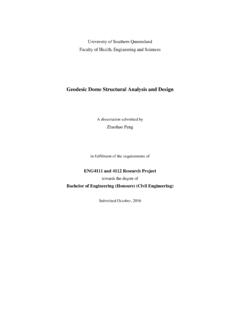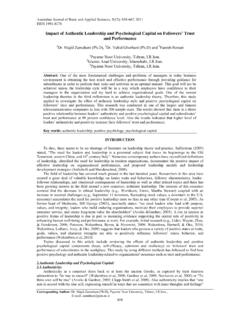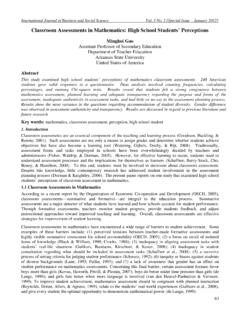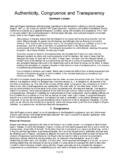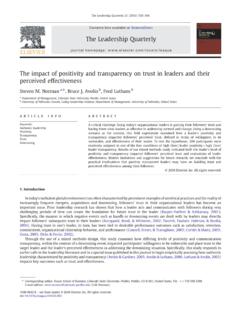Transcription of STUDENTS’ PERCEPTIONS OF ASSESSMENT PROCESS: …
1 STUDENTS' PERCEPTIONS OF ASSESSMENT PROCESS: QUESTIONNAIRE DEVELOPMENT AND VALIDATION. Bruce G. Waldrip University of Southern Queensland Australia Darrell L. Fisher Curtin University of Technology Australia Jeffrey P. Dorman Australian Catholic University Australia ABSTRACT. Research aimed at developing and validating an instrument to assess middle school students' PERCEPTIONS of ASSESSMENT was conducted. Following a review of literature, a tentative 6-scale instrument of 48 items was trialled with a sample of 320 students in 7 Australian schools. Based on internal consistency reliability data and exploratory factor analysis, refinement decisions resulted in a 5-scale instrument called the Student PERCEPTIONS of ASSESSMENT Questionnaire (SPAQ). The scales of the SPAQ are congruence with Planned Learning, authenticity , Student Consultation, transparency , and Diversity.
2 A sample of 3,098 students in 150 classrooms was used to validate the final SPAQ. INTRODUCTION. Despite the growth in emancipatory conceptualisations of classrooms that embrace a constructivist epistemology, little contemporary evidence exists to support the view that students are genuinely involved in decision-making about their ASSESSMENT tasks. That is, forms of ASSESSMENT and specific ASSESSMENT tasks employed in schools are overwhelmingly decided by teachers and administrators. Furthermore, even though reports like The Status and Quality of Teaching and Learning in Australia (Goodrum, Hackling, & Rennie, 2001) have asserted that ASSESSMENT is a key component of the teaching and learning process, teachers tend to utilise a very narrow range of ASSESSMENT strategies on which to base feedback to parents and students.
3 In practice, there is little evidence that teachers actually use diagnostic or formative ASSESSMENT strategies to inform planning and teaching (Radnor, 1996). This could be due to teachers feeling that they need to sacrifice learning with understanding for the goal of drilling students in the things for which they will be held accountable' (Hobden, 1998, p. 221). Historically, teachers have received substantial levels of advice on ASSESSMENT practices. Harlen (1998) advises teachers that both oral and written questions should be used in assessing student's learning. The inclusion of alternative ASSESSMENT strategies, such as teacher observation, personal communication, and student performances, demonstrations, and portfolios, have been offered by experts as having greater usefulness for evaluating students and informing classroom instruction (Brookhart, 1999; Stiggins, 1994).
4 Based on research with teachers, Barksdale-Ladd and Thomas (2000) identified five best practices in ASSESSMENT : x providing feedback to help students improve their learning;. x conceptualising ASSESSMENT as part of a student's work, which can go into a working portfolio;. x providing flexibility so that ASSESSMENT does not dominate the curriculum;. x ensuring that ASSESSMENT informs instruction to help teachers improve their teaching, thereby ensuring student learning; and x using more than one measuring stick to assess students' learning. Reynolds, Doran, Allers, and Agruso (1995) argued that for effective learning to occur, congruence must exist between instruction, ASSESSMENT and outcomes. Few textbooks on classroom teaching and ASSESSMENT suggest a substantive role for students in developing ASSESSMENT tasks.
5 This position is historically and culturally based and is rooted in an outdated assembly-line view of learning in which recitation of facts is highly prized. In today's information age, jobs are increasingly demanding higher levels of literacy skill and critical thinking and these demands require students to actively engage and monitor their learning rather than passively receive knowledge. This requires a fundamental review of how teachers involve students in ASSESSMENT tasks (Rogoff, 2001). An effective ASSESSMENT process should involve a two-way communication system between teachers and their students. Historically, teachers have used testing instruments to transmit to the student and their parents what is really important for the student to know and do. While this reporting tends to be in the form of a grade, the form and design of ASSESSMENT can send subtle messages on what is important.
6 There has been a substantial amount of research into 561. types of ASSESSMENT but very little research into students' PERCEPTIONS of ASSESSMENT (see , Black & Wiliam, 1998;. Crooks, 1998; Plake, 1993, Popham, 1997). In one of the few studies conducted on students' PERCEPTIONS of ASSESSMENT , an American sample of 174 students in Years 4 to 12 responded to a specially-designed questionnaire (Schaffner, Bury, Stock, Cho, Boney, & Hamilton, 2000). This research, which also elicited teachers' self-reported PERCEPTIONS of competence in the design and implementation of ASSESSMENT tasks, found that teachers were not asking students about what should be included in ASSESSMENT tasks. By including students in the teaching testing grading cycle, the validity of the ASSESSMENT processes can be enhanced and invalid ASSESSMENT instruments that result in very high failure rates can be avoided (see , Steinberg, 2000).
7 THE PRESENT STUDY. Aim The aim of the present study was to develop and validate an instrument to assess students' PERCEPTIONS of ASSESSMENT tasks for use with middle school students. Sample In the initial trial validation, a sample of 320 middle school students from Western Australia and Queensland responded to the tentative form of the Students' PERCEPTIONS of ASSESSMENT Questionnaire (SPAQ) described below. The final form was administered to 3,098 students in 150 classrooms. Methodological approach to development of the SPAQ. Fraser (1986) and Hase and Goldberg (1967) identified four approaches to the development of instruments: intuitive-rational, intuitive-theoretical, factor analytic and empirical group discriminative. While intuitive-rational and intuitive-theoretical scales rely on the nomination of items to tentative scales prior to questionnaire administration, factor analytic scales employ factor analysis to group items solely on the responses of a sample of the target population being investigated.
8 Empirical group discriminative scales also require test administration prior to scale formation but they are align with an external criterion by selecting items that maximise discrimination between groups of respondents. The SPAQ was developed using an intuitive rational approach to instrument design and validation. The validity of intuitive-rational scales rests partly on the subjective opinions of the investigators and other experts. There are three procedural steps to intuitive-rational scale development: (1) identification of salient dimensions, (2) writing sets of test items that are linked conceptually with each salient dimension, and (3) field testing the questionnaire. Identifying salient dimensions usually involves a review of literature and utilises the researchers' academic expertise. Writing test items utilises the subjective opinions of researchers with scale development knowledge.
9 Field testing involves administration of the questionnaire to a sample of the target population and studying the internal consistency (usually employing the Cronbach D coefficient as an index) and discriminant validity (using the mean correlation of a scale with the remaining scales as a convenient index) of each scale. Factor analysis can also be used to assist with scale refinement. DEVELOPMENT OF A TENTATIVE FORM OF THE STUDENTS' PERCEPTIONS OF. ASSESSMENT QUESTIONNAIRE (SPAQ). Identification of salient dimensions As indicated above, the first step in the intuitive-rational approach is the identification of salient dimensions. An extensive literature review was conducted with an analysis of over 64 policy and research papers on exemplary and effective ASSESSMENT practices, characteristics, principles, and techniques.
10 For example, McMillan (2000) identified authenticity , feedback opportunities, validity, fairness, ethical, efficient, feasible and utilising multiple methods as important characteristics of ASSESSMENT in schools. The North West Regional Educational Laboratory's (1995) research synthesis on effective schooling practices lists many characteristics of quality ASSESSMENT in schools including: reviewing ASSESSMENT instruments and methods for cultural and other bias, aligning assessments of student performance with the written curriculum and actual instruction, teaching students to evaluate their own work through peer and self- ASSESSMENT . Dietel, Herman and Knuth (1991) noted several important characteristics of good ASSESSMENT . Such ASSESSMENT : provides accurate estimates of student performance, is consistent and reliable, tests the full range of knowledge and skills, and is free of extraneous factors that confuse students.






